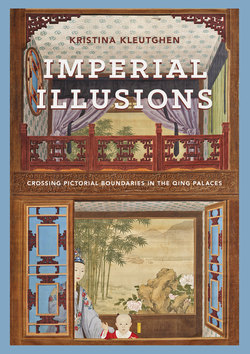Читать книгу Imperial Illusions - Kristina Kleutghen - Страница 39
На сайте Литреса книга снята с продажи.
Оглавлениеthat some became vegetarians and took up less bloody livelihoods in the hope of avoiding the fate that the artist depicted. His dragons emitted mist and flew away off the painting surfaces, while his figures of the demon-queller Zhong Kui—first produced for no less than emperor Xuanzong (r. 712–56) and pasted to the doors of all the houses in the empire—kept evil spirits at bay. Even the craggy rocks and rushing rivers of his landscapes seemed tangible and therefore real. While part of the critical discourse surrounding the assessments of any painter’s skills prioritized his ability to capture nature, during the Tang dynasty the discourse of perceived mural animation was intertwined with the alchemy of the large wall, the professional muralist, and pictorial styles that lent subjects mass, volume, and even life (or at least the appearance of it).
Despite a significant textual record of illusionistic murals after the Tang dynasty, comparatively few have survived relative to the vast numbers of more portable paintings in scroll and album formats, and post-Tang murals have not received anywhere near as much historical or historiographical consideration. During the Northern Song dynasty, painting academy artists serving the Huizong emperor (r. 1101–25) are recorded to have produced murals as well as large screen paintings for imperial temples and palaces such as the Daoist Temple of the Shangqing Precious Registers (Shangqing Baolugong) and the emperor’s own Dragon Virtue Palace (Longdegong). Although none of these are extant, murals continued to be used in northern Chinese tombs from the Northern Song through Yuan dynasties, and might therefore suggest something of the appearance of palace murals when considered alongside portable court paintings from the period.15 The colorful, highly detailed painting style of the Northern Song court painting academy is considered realistic for its “lively and fluid” figures produced with “an organic sense of form in multidirectional movement, as part of a fully integrated, optically convincing space.”16 At the time, paintings by Northern Song masters were explicitly described as making the viewer feel as if actually in the place depicted.17 Providing a sense of how close these paintings came to achieving that impression are those in a Song tomb (figure 1.2) excavated at Dengfeng, Henan. Here, detailed foreshortened figures in different scenes on different walls engage the viewer from within simulated architectural settings treated with horizontal spatial recession and filled with volumetric objects, all the elements working in concert to create an illusion of three dimensions. In one scene, a pair of figures is seated at a laden table, engrossed in each other as their maid looks out at the viewer. In another, a young woman, from behind a door that suggests another space behind her, also peers out at the viewer. Although admittedly flatter and more linear, the Song-style illusionism of these paintings suggests that their scenes of everyday life, material culture, and architecture are real and three-dimensional rather than painted and two-dimensional. Similar illusionistic murals have been uncovered in other tombs, but such discoveries are so recent that these paintings have yet to be fully integrated into the narrative of Chinese painting history.18 Nevertheless, even this single tomb mural indicates the continued ability of such murals to create a sense of animation and the illusion of reality well after the end of the Tang dynasty.
